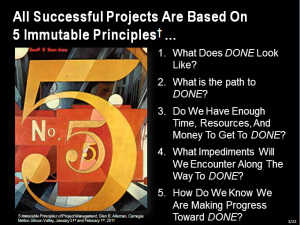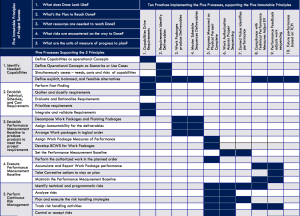![]()
I’d like to focus my contributions to GovLoop on managing projects in the presence of the uncertainties encountered in federal, state, and local domains to increase the probability of project success.
Through my experiences on federal programs and prime contractors working these programs, I’ve come to understand there are five immutable principles of project success. These five principles are applicable to any project in any domain, not just government.

The five principles for increasing the probability of success for any project are:
- What does Done look like?
Successful projects deliver business or technical capabilities to solve a problem, accomplish a mission, provide a service. Those paying for project bought this capability, not the work effort, not the cost expenditures, not the documentation, the test results, or the processes that delivered the capabilities. These are all needed, but they are not the value of the project. For success, the project must deliver tangible beneficial outcomes, assessed in units of measure meaningful to the decision makers.
- How do we reach Done as planned?
First, we need a plan. Plans are strategies for success. Strategies are hypotheses. Hypotheses require tests to confirm their validity. These tests are the outcomes of the work ‒ in the schedule ‒ measured against the needed capabilities of the buyer. The plan has to state these up front, otherwise, we’ll never recognize Done.
- Do we have enough time, money, and resources to reach Done?
A resource loaded schedule is required to assure our plan has the proper probability of success.
- What impediments will be encountered along our way to Done?
For project success we need to apply Tim Lister’s simple concept ‒ Risk Management is How Adults Manage Projects. All risk comes from uncertainty. Uncertainty comes in two forms ‒ (1) reducible (epistemic) and (2) irreducible (aleatory). A reducible risk is addressed with risk buy down activities, paid for by the customer. An irreducible risk is addressed with Margin – cost, schedule, and technical margin.
- What units of measure are used to confirm our progress to plan toward Done?
Progress to plan, for successful projects, is measured as physical percent complete. Not by the passage of time or consumption of money. Working products at the planned time, for the planned cost, compliant with the planned measures of effectiveness and measures of performance.
These are the five immutable principles of project success. I’ll be blogging in the coming weeks the details of each of these principles, and their processes and practices. All needed to increase the probability of project success.
In the coming weeks, the principles of project success will be connected with the processes and practices that can be applied to any project, in any domain, producing any product or service.

Glen Allenman is part of the GovLoop Featured Blogger program, where we feature blog posts by government voices from all across the country (and world!). To see more Featured Blogger posts, click here.





Leave a Reply
You must be logged in to post a comment.